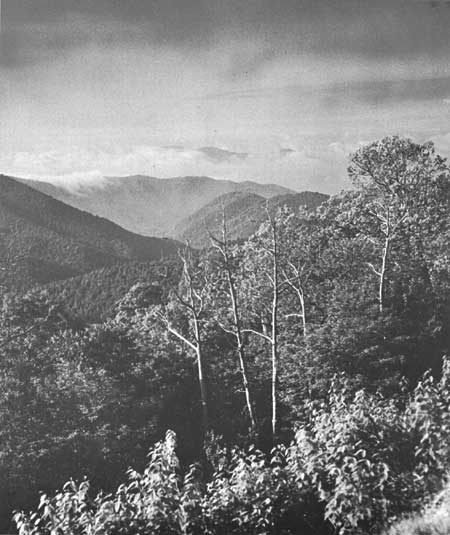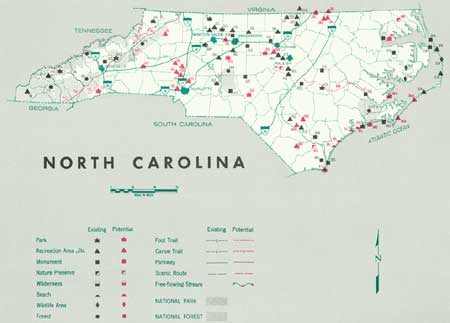.gif)
Parks for America
MENU
|
Parks for America
|

|

|
| Smith Island, part of the North Carolina Outer Banks, is one of the finest natural seashore areas remaining on the Atlantic coast and thus has exceptional potential as a State park. |
NORTH CAROLINA
LOCATED on the Atlantic seaboard between Virginia and South Carolina, North Carolina has three significant topographical divisions—the Mountain Region, the Piedmont Plateau, and the Coastal Plain.
The total population increased 12.1 percent in 10 years to 4,556,155 in 1960. Projections indicate 5,598,000 by 1976. Urban population is 39.5 percent of the total. The density ranges from less than 25 people per square mile in the mountains to over 500 in Mecklenburg County. Charlotte is the major metropolitan area, and anchors the "industrial crescent" which curves to the northeast through Winston-Salem and Greensboro to Raleigh.
Tourism, with an estimated value of $775 million in 1959, ranks third in the State's economy behind textiles and tobacco.
The State's planned program for highways will improve access to all places of recreation interest. Five interstate routes will reduce travel time to the mountains and piedmont areas. The main recreation resources are within weekend travel distance of the State's major urban areas.
Resources vary from forested mountain ranges with associated valleys, to rolling sandhills, seashore, and protected waters of the sounds. Seashore and mountains afford relief from summer heat and offer a 9-month recreation season. Forests cover about 60 percent of the State. Existing and planned reservoir impoundments are increasingly important.
Scene of the first attempt at English colonization in the New World as well as the first successful flight of heavier-than-air craft, North Carolina lends itself to development of many important sites where history is written upon the lands.
EXISTING PUBLIC AREAS
NATIONAL: The National Park Service administers one national park (partly in Tennessee), one national seashore, two national military parks, one national historic site, one national memorial, and one national parkway (partly in Virginia). They contain 334,615 acres and had an attendance of 11,774,400 in 1960. The Tennessee Valley Authority administers three reservoirs (one partly in Georgia) totaling 23,600 water-acres. The 1960 attendance was 1,168,650. Two of these reservoirs, with 16,650 water-acres, are tabulated. The Corps of Engineers administers one reservoir (partly in Virginia) of 53,200 water-acres. Its 75 access points had a 1959 attendance of 1,905,000. The Forest Service administers 35 recreation areas (about 900 acres) in 4 national forests totaling 1,123,798 acres. The Bureau of Sport Fisheries and Wildlife administers 3 refuges of 71,559 acres, having a 1960 attendance of 129,885.
STATE: The Division of State Parks administers 11 parks and 1 recreation area totaling 36,499 acres. The Historic Sites Division administers 11 monuments of 521 acres. The Kerr Reservoir Development Commission has 4 areas totaling 7,716 acres, and the State Highway Commission provides 23 wayside parks.
LOCAL: Seven recreation areas connected with municipal water-supply reservoirs and totaling 4,809 acres are administered by the cities of Greensboro, Raleigh, Durham, High Point, and Burlington. Winston-Salem operates three nonurban parks of 436 acres.
PRIVATE ENTERPRISE: Seacoast vacation and fishing resorts and facilities in the mountain region, especially near Great Smoky Mountains National Park, are supplied by private enterprise.
PARK AND RELATED NEEDS
Ocean beach reservation for public use is a major concern. Expansion of public recreation facilities is especially important in the piedmont, where population growth is greatest.
Existing State recreation areas provide 44,736 acres, and local areas, 6,360 acres for 4,556,155 residents. The present demand is so great than even if all of the potential areas identified in this plan (80,730 acres of State significance and 13,650 acres of local significance) were acquired and developed, the need would still not be met. That need will be even greater by 1976.

|
| Fifty more miles of mountain panoramas could be enjoyed from a Blue Ridge Parkway extension, proposed for North Carolina. |
RECOMMENDATIONS
Existing recreation resources and many potential areas are shown on the accompanying tabulation and map. Vigorous action on the part of the agencies concerned is urged to provide needed additional outdoor recreation opportunities for public enjoyment and use. The following recommendations may be helpful in this respect.
NATIONAL: Extension of the Blue Ridge Parkway and feasibility study of the suggested extension of Capd Hatteras National Seashore to protect the Cape Lookout area.
STATE: Addition of eight areas to the State park system to preserve more scenic, scientific, and natural resources of State significance. Expansion of nine existing units of State park system by addition of 17,100 acres to encompass complete landscapes and biotic units, and to provide for additional developments.
Provision of seven recreation areas to meet public recreation needs.
Study of the feasibility of establishing two scenic routes.
Designation of a system of canoe trails. Segment of two rivers are recommended for initial study.
Preservation of free-flowing streams in their natural state. Segments of three rivers are suggested for initial study in setting aside and preserving such areas.
LOCAL: Provision of parks, beaches, and recreation areas to meet local needs. Fifteen areas are suggested for study.
(Table omitted from online edition)

|
| (click on image for an enlargement in a new window) |
NEXT >>>
|
|
Last Modified: Mon, Sep 6 2004 10:00:00 pm PDT
parks_america/north_carolina.htm
 Top
Top